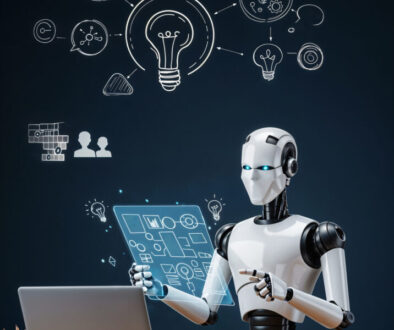Industries in Focus: How Technology is Transforming Key Sectors
Technology is reshaping industries at an unprecedented pace, from autonomous vehicles to AI-driven shopping experiences. This blog explores seven key sectors—Automotive, Locomotive, Discrete Manufacturing, Digital Commerce, Edtech, SaaS, and Hospitality & Entertainment—each undergoing a digital revolution.
How is robotics redefining manufacturing? How is AI transforming online shopping? These are just glimpses of the future unfolding before us. Join us as we dive into the game-changing innovations driving these industries forward.
1. Automotive Industry
In the fast lane of innovation, the automotive industry is accelerating with the integration of Artificial Intelligence (AI) and the Internet of Things (IoT). These technologies are not just add-ons but fundamental drivers transforming how we perceive and utilize vehicular transport.
- AI in Automotive Safety: AI technologies are increasingly employed to enhance vehicle safety. With features like predictive analytics and real-time decision-making, cars can now anticipate potential hazards on the road, adjust speed, and even apply brakes autonomously to prevent collisions.
- IoT Connecting the Dots: IoT devices enable vehicles to communicate with each other and with road infrastructure. This connectivity leads to smarter traffic management, reduced congestion, and more informed driving decisions, paving the way for a smoother ride.
- Future Trends:
- Autonomous Vehicle Technology: The journey toward fully autonomous vehicles is on the horizon. Advancements in sensor technology and machine learning models are setting the stage for cars that can navigate complex environments without human intervention.
- Integration with Smart Cities: As cities become smarter, vehicles are expected to seamlessly integrate into the urban ecosystem, communicating with traffic lights and parking systems to create a more cohesive and efficient urban transport experience.
2. Locomotive Industry
As the world moves faster, the locomotive industry isn’t just keeping pace—it’s leading the charge with groundbreaking technologies that redefine rail transport’s efficiency and sustainability.
- Predictive Maintenance Powered by Data Analytics: Imagine a world where train delays due to mechanical failures are a rarity. Through data analytics, the locomotive industry is making this a reality. By analyzing vast amounts of operational data, predictive maintenance technologies can forecast potential issues before they occur, scheduling maintenance only when necessary and significantly reducing downtime.
- Augmented Reality (AR) on the Rails:
- Training: AR is revolutionizing how train crews are trained. By overlaying digital information onto the real-world environment, AR provides hands-on training without the risks associated with live, moving trains. This technology allows for immersive learning experiences that can closely mimic real-life scenarios.
- Operations: Beyond training, AR is enhancing day-to-day operations. Engineers can use AR headsets to receive real-time data about train systems and track conditions, enabling them to make informed decisions quickly and efficiently.
- Shifting Gears to Greener Technology:
- Electrification of Tracks: Many sectors are embracing sustainability, and the locomotive industry is no exception. The shift toward electrifying tracks represents a significant move towards reducing carbon emissions. Electrified rail systems are not only cleaner but often offer higher performance and lower maintenance costs.
- Hydrogen Fuel Cells: Another exciting development is the use of hydrogen fuel cells in trains. This technology, which emits only water as a byproduct, is being tested in various regions as a viable alternative to diesel engines.
3. Discrete Manufacturing
The discrete manufacturing sector is undergoing a technological revolution, dramatically reshaping its landscape with smarter, faster, and more flexible production methods.
- Robotics and AI in Production Lines:
- Robotic Precision: In the fast-paced world of discrete manufacturing, robotics are now pivotal. These machines increase production rates, improve quality, and reduce waste by performing precise, repetitive tasks that once required human hands.
- AI Optimization: Artificial intelligence (AI) is taking this a step further by enabling these robots to learn from data and improve over time. AI algorithms can predict maintenance needs and adapt operations in real-time, ensuring optimal performance.
- Customization and 3D Printing: A New Era of Manufacturing:
- Personalization at Scale: The rise of 3D printing technology has introduced an unprecedented level of customization to manufacturing. From prosthetics tailored to individual patients to custom-designed parts for automobiles, manufacturers can now cater to unique customer needs without the traditional cost and time constraints.
- Shortened Product Development Cycles: 3D printing allows for rapid prototyping, speeding up the iteration process and helping bring products to market faster than ever before.
- Efficiency Gains Through Smart Inventory Management:
- Real-Time Data Analysis: Leveraging IoT devices, manufacturers have real-time visibility into their inventory levels. This connectivity not only prevents overproduction and understocking but also enhances the responsiveness of supply chains to market changes.
- Predictive Analytics: By analyzing historical and real-time data, manufacturers can anticipate demand trends, adjust production schedules, and reduce holding costs, significantly boosting overall efficiency.
4. Digital Commerce
The digital commerce landscape is being reshaped by the fusion of advanced technologies, enhancing user experiences and instilling trust in every transaction.
- AI-driven Personalization in E-commerce:
- Tailored Shopping Experiences: Artificial Intelligence is transforming online shopping into a highly personalized journey. By analyzing user data such as browsing patterns, purchase history, and even social media activity, AI tailors product recommendations and promotions to match the unique preferences of each shopper.
- Dynamic Pricing: AI also enables dynamic pricing strategies that can adjust prices in real-time based on demand, competition, and customer willingness to pay, ensuring that both retailers and consumers can find value in every deal.
- Blockchain: The New Standard for Trust and Transparency:
- Enhanced Security: Blockchain technology is revolutionizing the way transactions are recorded and validated, providing an immutable ledger that is nearly impossible to hack. This ensures that every transaction on an e-commerce platform is secure and transparent.
- Fraud Reduction: By decentralizing the storage of transaction data, blockchain significantly reduces the possibilities of fraud and ensures that no single point of failure can compromise the system.
- Voice and Visual Search Technologies: Breaking New Ground:
- Voice Search Optimization: With the rise of smart speakers and virtual assistants, voice search is becoming increasingly popular in online shopping. Retailers are now optimizing their platforms to respond effectively to voice commands, making shopping as easy as speaking.
- Visual Search Capabilities: Imagine snapping a photo of a desired product and instantly finding it available for purchase. Visual search technology makes this possible by allowing consumers to search for products using images instead of words, which is not only intuitive but also aligns with the visual nature of shopping.
5. Edtech Industry
The Edtech industry is at the forefront of a global educational revolution, leveraging cutting-edge technologies to create immersive, personalized, and accessible learning experiences that transcend traditional classroom boundaries.
- Virtual and Augmented Reality: Bringing Lessons to Life:
- Immersive Learning Environments: Virtual Reality (VR) and Augmented Reality (AR) are turning abstract concepts into tangible experiences. Imagine stepping into a virtual lab to conduct chemical experiments or exploring the Colosseum of ancient Rome from your classroom. These technologies make learning an engaging, multisensory experience.
- Enhanced Retention and Engagement: By interacting with the subject matter in a 3D space, students can understand complex subjects more effectively, leading to higher retention rates and deeper learning.
- Adaptive Learning Technologies:
- Customized Educational Journeys: Adaptive learning technology uses AI to analyze a student’s performance in real-time, adjusting the difficulty level of tasks and the pace of instruction based on their individual needs. This personalized approach helps maximize learning efficiency for each student.
- Feedback and Improvement: Continuous feedback provided by these systems allows students to understand their strengths and areas for improvement, fostering a more tailored and responsive educational experience.
- Global Outreach: Education Without Borders:
- Access to Global Resources: Edtech platforms can connect students with resources and experts around the world. Whether it’s a math tutorial from a renowned professor or access to exclusive libraries, learners can benefit from materials that were previously out of reach.
- Breaking Geographical Barriers: Online learning platforms and courses make education accessible to anyone with an internet connection, democratizing learning and providing opportunities regardless of location or socio-economic status.
6. SaaS Industry
The Software as a Service (SaaS) industry is a powerhouse of innovation, continuously adapting to leverage the cloud, machine learning, and cutting-edge security measures to serve businesses around the globe more effectively.
- Cloud Computing: The Backbone of Modern SaaS:
- Ubiquitous Access: The shift to cloud computing has democratized access to powerful business tools, allowing companies of all sizes to benefit from enterprise-grade software. Cloud-based SaaS solutions ensure that businesses can operate anywhere, anytime, without the need for extensive hardware investments.
- Scalability and Flexibility: With the cloud, SaaS platforms can scale resources up or down based on user demand, providing flexibility that is cost-effective and responsive to business needs.
- Machine Learning Enhancing SaaS Offerings:
- Predictive Analytics: Machine learning algorithms analyze vast amounts of data to predict trends and user behavior, enabling SaaS platforms to offer proactive insights to businesses. This can lead to more informed decision-making and improved strategies across various functions such as marketing, sales, and customer service.
- Automated Customer Service: AI-driven chatbots and automated systems provide round-the-clock customer service, reducing wait times and improving user satisfaction by resolving common queries quickly and efficiently.
- Security Innovations in SaaS:
- Advanced Threat Detection: As cyber threats evolve, so do the security measures implemented by SaaS providers. Using machine learning, these platforms can detect and respond to security threats in real time, staying one step ahead of potential breaches.
- Data Privacy and Compliance: With regulations like GDPR and CCPA in place, SaaS companies are not only improving their security features but also ensuring that they comply with data protection laws. This builds trust with users by safeguarding their sensitive information from unauthorized access.
7. Hospitality & Entertainment
In hospitality and entertainment, technology is not just enhancing the guest experience; it’s transforming it into something magical and deeply personalized.
- IoT for Personalized Guest Experiences:
- Smart Room Customizations: Hotels are adopting Internet of Things (IoT) technology to offer guests unprecedented control over their room features. From adjusting the thermostat to setting the mood lighting, all can be managed from a smartphone or voice-activated device, making each stay uniquely tailored to individual preferences.
- Seamless Service Delivery: IoT also streamlines operations, enabling staff to provide timely services based on real-time data. For example, sensors can alert housekeeping when a guest has left the room, optimizing cleaning schedules without intruding on privacy.
- Virtual Reality: Previewing Destinations Before Visiting:
- Virtual Tours: Travel agencies and tourist destinations are using virtual reality (VR) to offer potential visitors a glimpse of what they can expect. From the comfort of home, people can explore hotel rooms, local attractions, and even remote wilderness areas, which helps them make informed decisions about their travel plans.
- Enhanced Marketing Tool: VR acts as a powerful marketing tool, providing immersive previews that traditional photos and videos cannot match. This not only boosts customer engagement but also increases conversion rates by enticing travelers with a realistic taste of their possible experiences.
- Technological Innovations in Live Entertainment:
- Augmented Reality (AR) Concerts: The entertainment industry is leveraging AR to create interactive concert experiences, where fans can see virtual stages and performances that feel both futuristic and engaging.
- Drones and Light Shows: Tech-driven performances now often include synchronized drone displays and advanced light shows, which add an extra layer of spectacle to live events, making them unforgettable.
Conclusion
Technology is reshaping industries, offering innovations that transform business operations and enhance customer experiences. At ConnectedX, we’re driving this revolution, helping you leverage these technologies to gain a competitive edge.
Ready to innovate? Contact us to discover how our solutions can propel your business into the future. Let’s create something extraordinary together.




